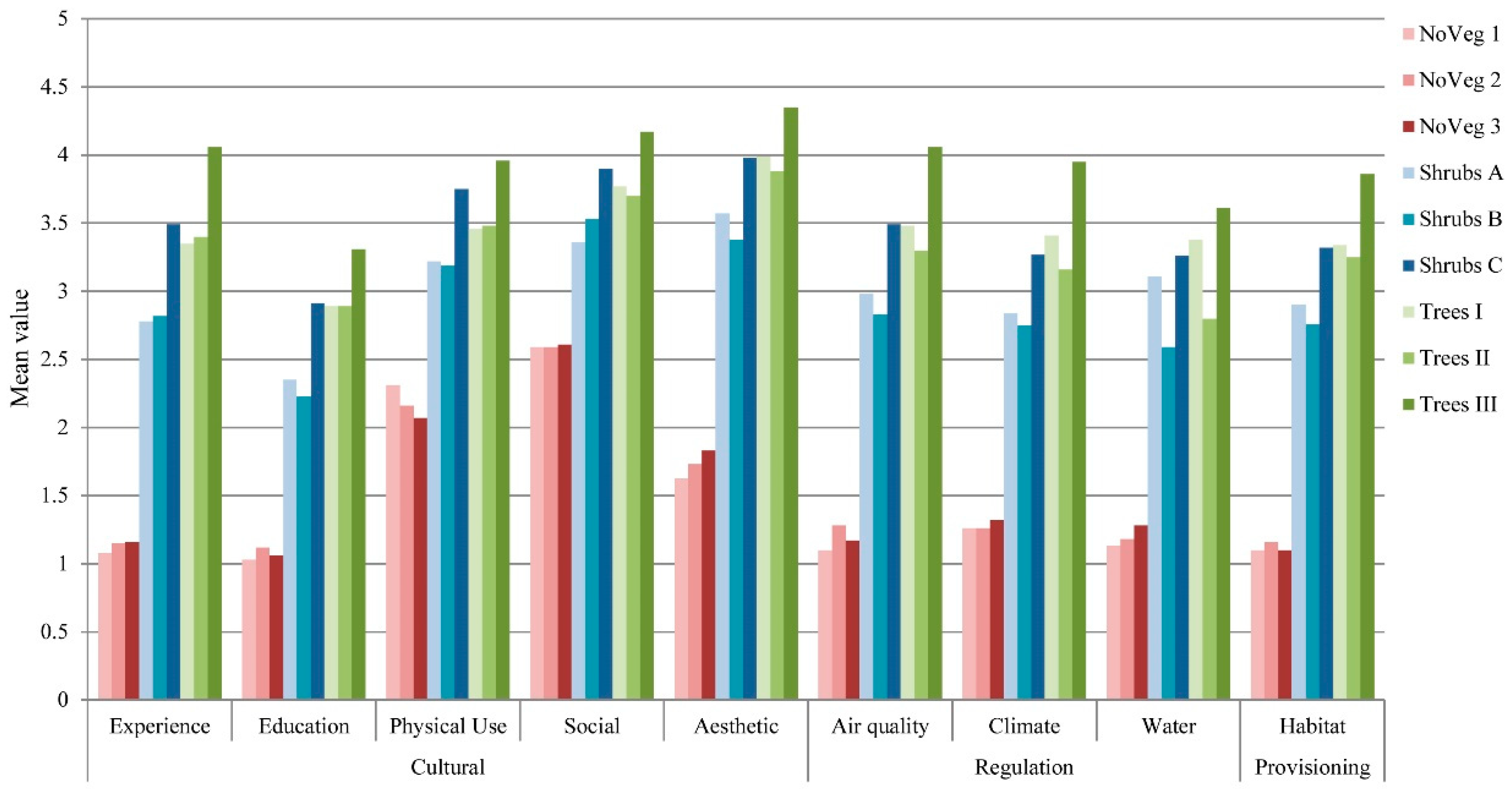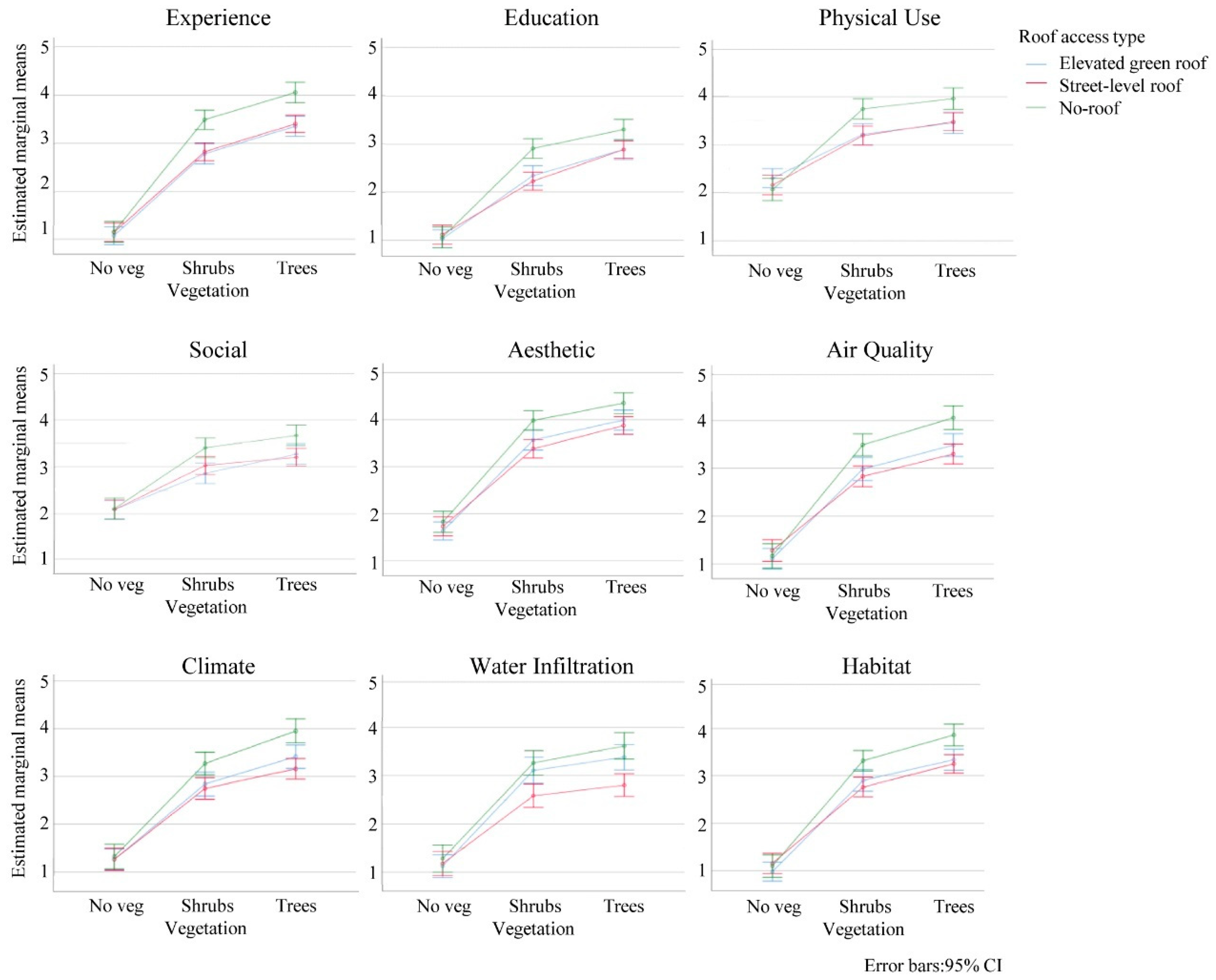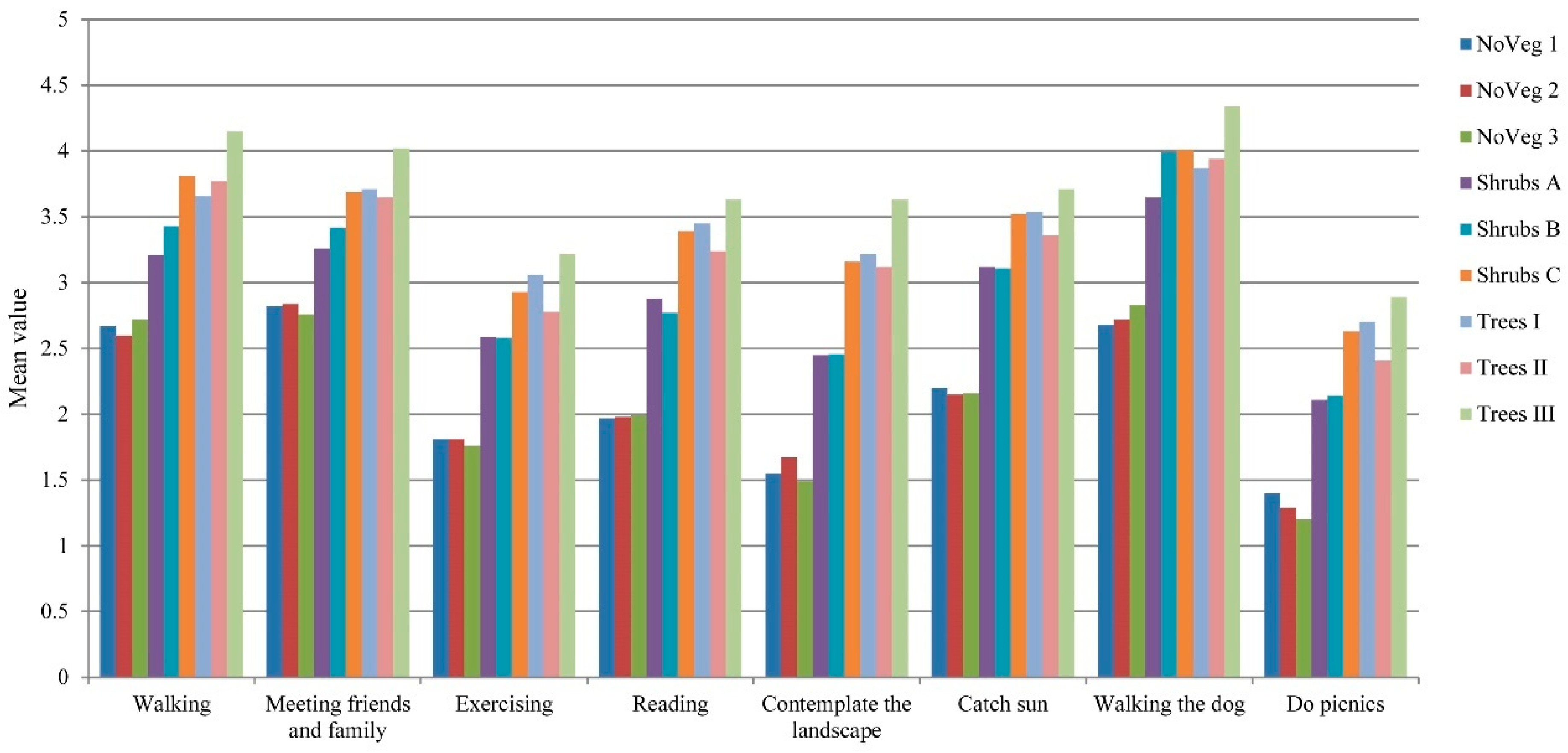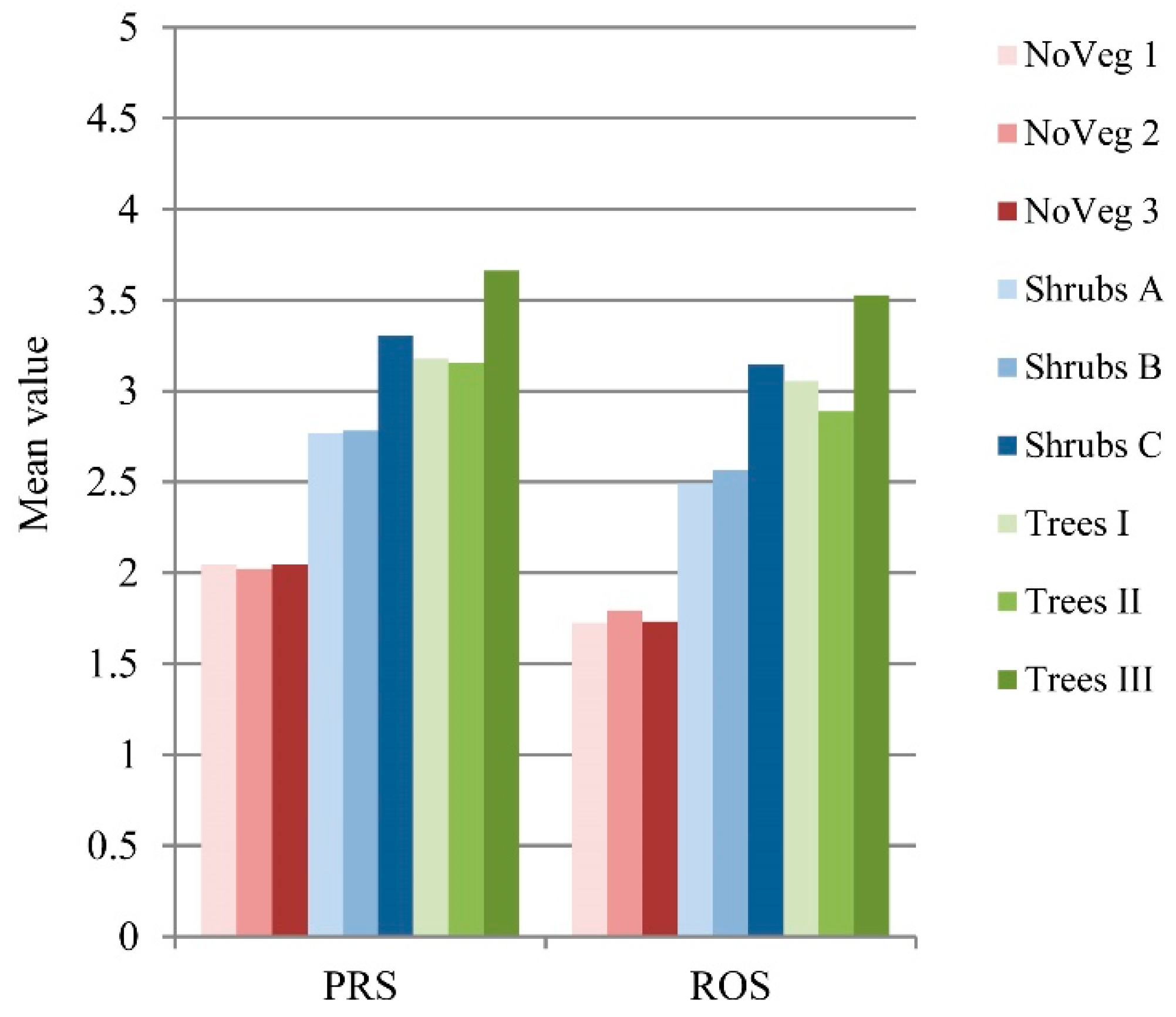Green Spaces over a Roof or on the Ground, Does It Matter? The Perception of Ecosystem Services and Potential Restorative Effects
Abstract
1. Introduction
2. Materials and Methods
2.1. Survey Structure
2.2. Methods
3. Results and Discussion
3.1. Sample Characteristics
3.2. Perception of Ecosystem Services

3.3. Access Preference
3.4. Cultural Ecosystem Services
3.4.1. Activities
3.4.2. Perceived Restorativeness and Restoration Outcome
4. Conclusions
Author Contributions
Funding
Informed Consent Statement
Conflicts of Interest
References
- CBD. Urban Biodiversity and the Role of Cities in Biodiversity Conservation and Sustainable Use Discussed at Bonn Biodiversity Conference. 2008. Available online: https://www.cbd.int/doc/press/2008/pr-2008-05-26-cities-en.pdf (accessed on 15 September 2022).
- UN. Transforming Our World: The 2030 Agenda for Sustainable Development; United Nations: New York, NY, USA, 2015; Available online: https://sdgs.un.org/2030agenda (accessed on 14 September 2022).
- Surge, G. GREEN SURGE: All Deliverables. Available online: https://ign.ku.dk/english/green-surge/bokse/green-surge-all-deliverables/ (accessed on 14 September 2021).
- Gómez-Baggethun, E.; Gren, Å.; Barton, D.N.; Langemeyer, J.; McPhearson, T.; O’farrell, P.; Andersson, E.; Hamstead, Z.; Kremer, P. Urban ecosystem services. In Urbanization, Biodiversity and Ecosystem Services: Challenges and Opportunities; Springer: Dordrecht, The Netherlands, 2013; pp. 175–251. [Google Scholar]
- Wood, E.; Harsant, A.; Dallimer, M.; Cronin de Chavez, A.; McEachan, R.R.; Hassall, C. Not all green space is created equal: Biodiversity predicts psychological restorative benefits from urban green space. Front. Psychol. 2018, 9, 2320. [Google Scholar] [CrossRef] [PubMed]
- Whitford, V.; Ennos, A.R.; Handley, J.F. “City form and natural process”—Indicators for the ecological performance of urban areas and their application to Merseyside, UK. Landsc. Urban Plan. 2001, 57, 91–103. [Google Scholar] [CrossRef]
- Barthel, S.; Parker, J.; Ernstson, H. Food and green space in cities: A resilience lens on gardens and urban environmental movements. Urban Stud. 2015, 52, 1321–1338. [Google Scholar] [CrossRef]
- Bertnatzky, A. The contribution of trees and green spaces to a town climate. Energy Build. 1982, 5, 1. [Google Scholar] [CrossRef]
- De Manuel, B.F.; Méndez-Fernández, L.; Peña, L.; Ametzaga-Arregi, I. A new indicator of the effectiveness of urban green infrastructure based on ecosystem services assessment. Basic Appl. Ecol. 2021, 53, 12–25. [Google Scholar] [CrossRef]
- Dickinson, D.C.; Hobbs, R.J. Cultural ecosystem services: Characteristics, challenges and lessons for urban green space research. Ecosyst. Serv. 2017, 25, 179–194. [Google Scholar] [CrossRef]
- Kabisch, N.; van den Bosch, M.; Lafortezza, R. The health benefits of nature-based solutions to urbanization challenges for children and the elderly–A systematic review. Environ. Res. 2017, 159, 362–373. [Google Scholar] [CrossRef]
- Subiza-Pérez, M.; Vozmediano, L.; San Juan, C. Green and blue settings as providers of mental health ecosystem services: Comparing urban beaches and parks and building a predictive model of psychological restoration. Landsc. Urban Plan. 2020, 204, 103926. [Google Scholar] [CrossRef]
- Cleary, A.; Roiko, A.; Burton, N.W.; Fielding, K.S.; Murray, Z.; Turrell, G. Changes in perceptions of urban green space are related to changes in psychological well-being: Cross-sectional and longitudinal study of mid-aged urban residents. Health Place 2019, 59, 102201. [Google Scholar] [CrossRef]
- Zhu, X.; Gao, M.; Zhang, R.; Zhang, B. Quantifying emotional differences in urban green spaces extracted from photos on social networking sites: A study of 34 parks in three cities in northern China. Urban For. Urban Green. 2021, 62, 127133. [Google Scholar] [CrossRef]
- Van den Berg, A.E.; Jorgensen, A.; Wilson, E.R. Evaluating restoration in urban green spaces: Does setting type make a difference? Landsc. Urban Plan. 2014, 127, 173–181. [Google Scholar] [CrossRef]
- Chiesura, A. The role of urban parks for the sustainable city. Landsc. Urban Plan. 2004, 68, 129–138. [Google Scholar] [CrossRef]
- Aoshima, I.; Uchida, K.; Ushimaru, A.; Sato, M. The influence of subjective perceptions on the valuation of green spaces in Japanese urban areas. Urban For. Urban Green. 2018, 34, 166–174. [Google Scholar] [CrossRef]
- Grahn, P.; Stigsdotter, U.K. The relation between perceived sensory dimensions of urban green space and stress restoration. Landsc. Urban Plan. 2010, 94, 264–275. [Google Scholar] [CrossRef]
- Hedblom, M.; Gunnarsson, B.; Iravani, B.; Knez, I.; Schaefer, M.; Thorsson, P.; Lundström, J.N. Reduction of physiological stress by urban green space in a multisensory virtual experiment. Sci. Rep. 2019, 9, 10113. [Google Scholar] [CrossRef]
- Ma, R.; Luo, Y.; Furuya, K. Gender Differences and Optimizing Women’s Experiences: An Exploratory Study of Visual Behavior While Viewing Urban Park Landscapes in Tokyo, Japan. Sustainability 2023, 15, 3957. [Google Scholar] [CrossRef]
- Nordh, H.; Alalouch, C.; Hartig, T. Assessing restorative components of small urban parks using conjoint methodology. Urban For. Urban Green. 2011, 10, 95–103. [Google Scholar] [CrossRef]
- Paraskevopoulou, A.T.; Chletsou, M.; Malesios, C. Runners Experience Lower Heart Rate, Increased Speed, and Joy/Calm on Routes with Trees, by the Sea and through Parks: Implications for Climate Change Design. Sustainability 2022, 14, 16280. [Google Scholar] [CrossRef]
- Holt, E.W.; Lombard, Q.K.; Best, N.; Smiley-Smith, S.; Quinn, J.E. Active and passive use of green space, health, and well-being amongst university students. Int. J. Environ. Res. Public Health 2019, 16, 424. [Google Scholar] [CrossRef]
- Ugolini, F.; Massetti, L.; Calaza-Martínez, P.; Cariñanos, P.; Dobbs, C.; Ostoić, S.K.; Marin, A.M.; Pearlmutter, D.; Saaroni, H.; Šaulienė, I. Effects of the COVID-19 pandemic on the use and perceptions of urban green space: An international exploratory study. Urban For. Urban Green. 2020, 56, 126888. [Google Scholar] [CrossRef]
- Manso, M.; Sousa, V.; Silva, C.M.; Cruz, C.O. The role of green roofs in post COVID-19 confinement: An analysis of willingness to pay. J. Build. Eng. 2021, 44, 103388. [Google Scholar] [CrossRef]
- Derkzen, M.L.; van Teeffelen, A.J.; Verburg, P.H. Quantifying urban ecosystem services based on high-resolution data of urban green space: An assessment for Rotterdam, the Netherlands. J. Appl. Ecol. 2015, 52, 1020–1032. [Google Scholar] [CrossRef]
- Elderbrock, E.; Enright, C.; Lynch, K.A.; Rempel, A.R. A Guide to Public Green Space Planning for Urban Ecosystem Services. Land 2020, 9, 391. [Google Scholar] [CrossRef]
- Haase, D.; Larondelle, N.; Andersson, E.; Artmann, M.; Borgström, S.; Breuste, J.; Gomez-Baggethun, E.; Gren, Å.; Hamstead, Z.; Hansen, R. A quantitative review of urban ecosystem service assessments: Concepts, models, and implementation. Ambio 2014, 43, 413–433. [Google Scholar] [CrossRef]
- Zhang, H.; Chen, B.; Sun, Z.; Bao, Z. Landscape perception and recreation needs in urban green space in Fuyang, Hangzhou, China. Urban For. Urban Green. 2013, 12, 44–52. [Google Scholar] [CrossRef]
- Zhang, X.; Ni, Z.; Wang, Y.; Chen, S.; Xia, B. Public perception and preferences of small urban green infrastructures: A case study in Guangzhou, China. Urban For. Urban Green. 2020, 53, 126700. [Google Scholar] [CrossRef]
- Wendel, H.E.W.; Zarger, R.K.; Mihelcic, J.R. Accessibility and usability: Green space preferences, perceptions, and barriers in a rapidly urbanizing city in Latin America. Landsc. Urban Plan. 2012, 107, 272–282. [Google Scholar] [CrossRef]
- White, E.V.; Gatersleben, B. Greenery on residential buildings: Does it affect preferences and perceptions of beauty? J. Environ. Psychol. 2011, 31, 89–98. [Google Scholar] [CrossRef]
- Miller, S.M.; Montalto, F.A. Stakeholder perceptions of the ecosystem services provided by Green Infrastructure in New York City. Ecosyst. Serv. 2019, 37, 100928. [Google Scholar] [CrossRef]
- Cvejić, R.; Eler, K.; Pintar, M.; Železnikar, Š.; Haase, D.; Kabisch, N.; Strohbach, M.; Haase, D. Green Surge Report D3.1: A Typology of Urban Green Spaces, Ecosystem Services Provisioning Services and Demands. 2015. Available online: https://ign.ku.dk/english/green-surge/rapporter/D3.3__Classification_of_UGI.pdf (accessed on 15 September 2022).
- Haase, D.; Kabisch, N.; Pintar, M.; Strohbach, M.; Zeleznikar, S.; Cvejic, R.; Eler, K. Green Surge Report D3.3: Classification of UGI Based on Their Functionality, Services, Synergies, Trade-Offs and Spacial Conflicts. Version 1. 30th August 2016. Available online: https://ign.ku.dk/english/green-surge/rapporter/D3.3__Classification_of_UGI.pdf (accessed on 15 September 2022).
- Oberndorfer, E.; Lundholm, J.; Bass, B.; Coffman, R.R.; Doshi, H.; Dunnett, N.; Gaffin, S.; Köhler, M.; Liu, K.K.Y.; Rowe, B. Green Roofs as Urban Ecosystems: Ecological Structures, Functions, and Services. BioScience 2007, 57, 823–833. [Google Scholar] [CrossRef]
- Manso, M.; Teotónio, I.; Silva, C.M.; Cruz, C.O. Green roof and green wall benefits and costs: A review of the quantitative evidence. Renew. Sustain. Energy Rev. 2021, 135, 110111. [Google Scholar] [CrossRef]
- Bignante, E. The use of photo-elicitation in field research. EchoGéo 2010, 11. [Google Scholar] [CrossRef]
- Glaw, X.; Inder, K.; Kable, A.; Hazelton, M. Visual methodologies in qualitative research: Autophotography and photo elicitation applied to mental health research. Int. J. Qual. Methods 2017, 16, 1–8. [Google Scholar] [CrossRef]
- Barroso, F.L.; Pinto-Correia, T.; Ramos, I.L.; Surová, D.; Menezes, H. Dealing with landscape fuzziness in user preference studies: Photo-based questionnaires in the Mediterranean context. Landsc. Urban Plan. 2012, 104, 329–342. [Google Scholar] [CrossRef]
- Nassauer, J.I.; Wang, Z.; Dayrell, E. What will the neighbors think? Cultural norms and ecological design. Landsc. Urban Plan. 2009, 92, 282–292. [Google Scholar] [CrossRef]
- Hami, A.; Abdi, B. Students’ landscaping preferences for open spaces for their campus environment. Indoor Built Environ. 2021, 30, 87–98. [Google Scholar] [CrossRef]
- Van den Bogerd, N.; Dijkstra, S.C.; Seidell, J.C.; Maas, J. Greenery in the university environment: Students’ preferences and perceived restoration likelihood. PLoS ONE 2018, 13, e0192429. [Google Scholar] [CrossRef]
- State, K.; Hudson, M. Accessibility and Pressures of a Growing Student Population on Urban Green Spaces. Meliora Int. J. Stud. Sustain. Res. 2019, 2. [Google Scholar] [CrossRef]
- Akpinar, A. How is high school greenness related to students’ restoration and health? Urban For. Urban Green. 2016, 16, 1–8. [Google Scholar] [CrossRef]
- Speake, J.; Edmondson, S.; Nawaz, H. Everyday encounters with nature: Students’perceptions and use of university campus green spaces. Hum. Geogr.-J. Stud. Res. Hum. Geogr. 2013, 7, 21–31. [Google Scholar] [CrossRef]
- Casado-Arzuaga, I.; Onaindia, M.; Madariaga, I.; Verburg, P.H. Mapping recreation and aesthetic value of ecosystems in the Bilbao Metropolitan Greenbelt (northern Spain) to support landscape planning. Landsc. Ecol. 2014, 29, 1393–1405. [Google Scholar] [CrossRef]
- Schmidt, K.; Walz, A.; Martín-López, B.; Sachse, R. Testing socio-cultural valuation methods of ecosystem services to explain land use preferences. Ecosyst. Serv. 2017, 26, 270–288. [Google Scholar] [CrossRef]
- Negrín, F.; Hernández-Fernaud, E.; Hess, S.; Hernández, B. Discrimination of urban spaces with different level of restorativeness based on the original and on a shorter version of hartig et al.’s perceived restorativeness scale. Front. Psychol. 2017, 8, 1735. [Google Scholar] [CrossRef]
- Korpela, K.M.; Ylén, M.; Tyrväinen, L.; Silvennoinen, H. Determinants of restorative experiences in everyday favorite places. Health Place 2008, 14, 636–652. [Google Scholar] [CrossRef]
- Korpela, K.M.; Ylén, M.; Tyrväinen, L.; Silvennoinen, H. Favorite green, waterside and urban environments, restorative experiences and perceived health in Finland. Health Promot. Int. 2010, 25, 200–209. [Google Scholar] [CrossRef]
- Schwarz, N.; Moretti, M.; Bugalho, M.N.; Davies, Z.G.; Haase, D.; Hack, J.; Hof, A.; Melero, Y.; Pett, T.J.; Knapp, S. Understanding biodiversity-ecosystem service relationships in urban areas: A comprehensive literature review. Ecosyst. Serv. 2017, 27, 161–171. [Google Scholar] [CrossRef]
- Bernardo, F.; Loupa-Ramos, I.; Silva, C.M.; Manso, M. The Restorative Effect of the Presence of Greenery on the Classroom in Children’s Cognitive Performance. Sustainability 2021, 13, 3488. [Google Scholar] [CrossRef]
- Lai, S.; Deal, B. Parks, Green Space, and Happiness: A Spatially Specific Sentiment Analysis Using Microblogs in Shanghai, China. Sustainability 2023, 15, 146. [Google Scholar] [CrossRef]







| Simulation Combinations | |||||||||
|---|---|---|---|---|---|---|---|---|---|
| A1I | B2II | C3III | IIIB1 | IC2 | IIA3 | 1IIC | 2IIIA | 3IB | |
| N Total = 376 | 46 | 62 | 33 | 42 | 34 | 34 | 56 | 33 | 36 |
| No Vegetation | With Vegetation | ||
|---|---|---|---|
| Shrubs | Trees | ||
| Elevated roof | 144 | 113 | 116 |
| Ground-level roof | 129 | 140 | 152 |
| No roof | 103 | 123 | 108 |
| Total | 376 | 376 | 376 |
| Ecosystem Services | Variables | No Vegetation | Shrubs | Trees | F | Sig | Power |
|---|---|---|---|---|---|---|---|
| Vegetation | 1.12 | 3.03 | 3.57 | 487.424 | 0.000 | 1.000 | |
| Experience | Roof access | 2.30 | 2.52 | 2.95 | 20.344 | 0.000 | 1.000 |
| Veg* Roof access | 4.095 | 0.003 | 0.918 | ||||
| Vegetation | 1.07 | 2.49 | 3.01 | 295.322 | 0.000 | 1.000 | |
| Education | Roof access | 2.01 | 2.13 | 2.47 | 10.713 | 0.000 | 1.000 |
| Veg* Roof access | 3.493 | 0.008 | 0.990 | ||||
| Vegetation | 2.19 | 3.38 | 3.61 | 156.241 | 0.000 | 1.000 | |
| Physical Use | Roof access | 2.94 | 2.98 | 3.30 | 7.090 | 0.001 | 1.000 |
| Veg* Roof access | 4.344 | 0.002 | 0.931 | ||||
| Vegetation | 2.60 | 3.60 | 3.86 | 121.422 | 0.000 | 1.000 | |
| Social | Roof access | 3.19 | 3.30 | 3.59 | 7.812 | 0.000 | 1.000 |
| Veg* Roof access | 1.971 | 0.097 | 0.952 | ||||
| Vegetation | 1.72 | 3.63 | 4.05 | 421.615 | 0.000 | 1.000 | |
| Aesthetic | Roof access | 2.95 | 3.05 | 3.44 | 11.485 | 0.000 | 0.994 |
| Veg* Roof access | 1.568 | 0.181 | 0.488 | ||||
| Vegetation | 1.18 | 3.09 | 3.57 | 353.725 | 0.000 | 1.000 | |
| Air Quality | Roof access | 2.41 | 2.52 | 2.96 | 11.613 | 0.000 | 1.000 |
| Veg* Roof access | 3.971 | 0.003 | 0.994 | ||||
| Vegetation | 1.28 | 2.95 | 3.47 | 273.881 | 0.000 | 1.000 | |
| Climate | Roof access | 2.41 | 2.44 | 2.89 | 11.217 | 0.000 | 1.000 |
| Veg* Roof access | 2.379 | 0.050 | 0.992 | ||||
| Water Infiltration | Vegetation | 1.19 | 2.96 | 3.21 | 220.987 | 0.000 | 1.000 |
| Roof access | 2.43 | 2.23 | 2.76 | 13.073 | 0.000 | 0.994 | |
| Veg* Roof access | 2.676 | 0.031 | 0.747 | ||||
| Vegetation | 1.07 a | 2.99 b | 3.86 c | 396.744 | 0.000 | 1.000 | |
| Habitat | Roof access | 2.29 a | 2.45 a | 2.81 b | 10.148 | 0.000 | 0.986 |
| Veg* Roof access | 2.743 | 0.027 | 0.759 |
| Activities | Variables | No Vegetation | Shrubs | Trees | F | Sig | Power |
|---|---|---|---|---|---|---|---|
| Roof access | 3.18 | 3.27 | 3.56 | 10.242 | 0.000 | 0.987 | |
| Walking | Vegetation | 2.66 | 3.49 | 3.86 | 102.446 | 0.000 | 1.000 |
| Veg* Roof access | 1.937 | 0.102 | 0.587 | ||||
| Roof access | 3.26 | 3.30 | 3.49 | 3.967 | 0.019 | 0.712 | |
| Meeting friends and family | Vegetation type | 2.81 | 3.46 | 3.80 | 72.202 | 0.000 | 1.000 |
| Veg* Roof | 2.031 | 0.088 | 0.610 | ||||
| Roof access | 2.44 | 2.42 | 2.66 | 4.050 | 0.018 | 0.722 | |
| Exercising | Vegetation type | 1.80 | 2.70 | 2.99 | 107.315 | 0.000 | 1.000 |
| Veg* Roof access | 1.923 | 0.104 | 0.583 | ||||
| Roof access | 2.71 | 2.70 | 3.04 | 7.584 | 0.001 | 0.946 | |
| Reading | Vegetation type | 1.98 | 3.01 | 3.42 | 145.701 | 0.000 | 1.000 |
| Veg* Roof access | 2.349 | 0.053 | 0.683 | ||||
| Roof access | 2.34 | 2.46 | 2.80 | 11.604 | 0.000 | 0.994 | |
| Contemplate the landscape | Vegetation type | 1.57 | 2.69 | 3.30 | 242.245 | 0.000 | 1.000 |
| Veg* Roof access | 6.220 | 0.000 | 0.989 | ||||
| Roof access | 2.90 | 2.90 | 3.16 | 4.423 | 0.012 | 0.762 | |
| Catch the sun | Vegetation type | 2.17 | 3.25 | 3.52 | 135.729 | 0.000 | 1.000 |
| Veg* Roof access | 1.474 | 0.208 | 0.461 | ||||
| Roof access | 3.34 | 3.58 | 3.75 | 6.201 | 0.002 | 0.893 | |
| Walking the dog | Vegetation type | 2.73 | 3.89 | 4.03 | 124.790 | 0.000 | 1.000 |
| Veg* Roof access | 1.360 | 0.246 | 0.427 | ||||
| Have picnics | Roof access | 2.02 | 1.97 | 2.27 | 6.800 | 0.001 | 0.920 |
| Vegetation type | 1.31 | 2.29 | 2.64 | 153.887 | 0.000 | 1.000 | |
| Veg* Roof access | 4.271 | 0.002 | 0.929 |
| No Vegetation | Shrubs | Trees | F (sig) | |||||||
|---|---|---|---|---|---|---|---|---|---|---|
| 1 | 2 | 3 | A | B | C | I | II | III | ||
| PRS Mean N | 2.0472 | 2.0217 | 2.0466 | 2.7681 | 2.7814 | 3.3057 | 3.1776 | 3.1566 | 3.6630 | 67.48 (0.000) |
| ROS Mean N | 1.7266 | 1.7936 | 1.7330 | 2.4934 | 2.5670 | 3.1484 | 3.0560 | 2.8865 | 3.5278 | 67.74 (0.000) |
| No Vegetation | Shrubs | Trees | F | Sig | Power | |
|---|---|---|---|---|---|---|
| Vegetation | 2.0383 a | 2.9489 b | 3.3085 c | 241.227 | 0.000 | 1.000 |
| Roof access | 2.6172 a | 2.6841 a | 3.0329 b | 20.793 | 0.000 | 1.000 |
| Vegetation* Roof access | 4.775 | 0.001 | 0.955 |
| No Vegetation | Shrubs | Trees | F | Sig | Power | |
|---|---|---|---|---|---|---|
| Vegetation | 1.7513 a | 2.7350 b | 3.1230 c | 239.294 | 0.000 | 1.000 |
| Roof access | 2.3723 a | 2.4454 a | 2.8346 b | 21.362 | 0.000 | 1.000 |
| Vegetation* Roof access | 6.830 | 0.001 | 0.994 |
Disclaimer/Publisher’s Note: The statements, opinions and data contained in all publications are solely those of the individual author(s) and contributor(s) and not of MDPI and/or the editor(s). MDPI and/or the editor(s) disclaim responsibility for any injury to people or property resulting from any ideas, methods, instructions or products referred to in the content. |
© 2023 by the authors. Licensee MDPI, Basel, Switzerland. This article is an open access article distributed under the terms and conditions of the Creative Commons Attribution (CC BY) license (https://creativecommons.org/licenses/by/4.0/).
Share and Cite
Matos Silva, C.; Bernardo, F.; Manso, M.; Loupa Ramos, I. Green Spaces over a Roof or on the Ground, Does It Matter? The Perception of Ecosystem Services and Potential Restorative Effects. Sustainability 2023, 15, 5334. https://doi.org/10.3390/su15065334
Matos Silva C, Bernardo F, Manso M, Loupa Ramos I. Green Spaces over a Roof or on the Ground, Does It Matter? The Perception of Ecosystem Services and Potential Restorative Effects. Sustainability. 2023; 15(6):5334. https://doi.org/10.3390/su15065334
Chicago/Turabian StyleMatos Silva, Cristina, Fátima Bernardo, Maria Manso, and Isabel Loupa Ramos. 2023. "Green Spaces over a Roof or on the Ground, Does It Matter? The Perception of Ecosystem Services and Potential Restorative Effects" Sustainability 15, no. 6: 5334. https://doi.org/10.3390/su15065334
APA StyleMatos Silva, C., Bernardo, F., Manso, M., & Loupa Ramos, I. (2023). Green Spaces over a Roof or on the Ground, Does It Matter? The Perception of Ecosystem Services and Potential Restorative Effects. Sustainability, 15(6), 5334. https://doi.org/10.3390/su15065334







